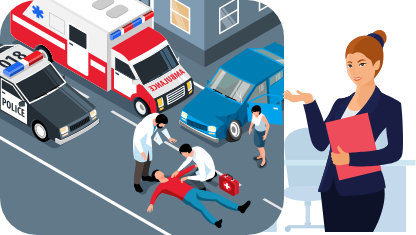Personal accident insurance cover pays a fixed amount if an employee has an accident.
The following are the standard coverages in personal accident insurance:
- Accidental Death: Death because of a car crash, or any other unfortunate accident is covered by personal accident insurance. If the insured dies in an accident, the beneficiary receives compensation of 100% sum assured. The company that buys the insurance can also receive the amount.
- Permanent Total Disablement: Any accidental injury which makes it impossible for the insured to work for the rest of his or her life. Permanent disability refers to the permanent loss of functionality of both limbs or feet or loss of vision that makes the person unable to work. The insured receives a 100% payout in case of permanent total disablement.
- Permanent Partial Disablement: Any accidental injury which reduces the efficiency because of partial loss of functionality in one or more limbs and there is no chance of recovery or treatment. The insurance covers permanent partial disablement such as loss of vision in one eye, knee injury, or nerve damage. The coverage is only as per the sub-limit. This can vary between 50 to 100% depending upon the terms of the policy.
- Temporary Total Disablement: Any accidental injury which exists only on a temporary basis such as fracture is also covered with a specified sub-limit payout of the sum insured. In such cases, the insured will return to work eventually within a few days or months with their original efficiency. In such cases, the insured will receive weekly compensation of 1 percent of the sum insured for up to 100 weeks, depending on the type of policy. This amount can vary by insurance and customized.
More categories of coverage
- Terrorism: Injuries afflicted because of terrorist acts are covered by personal accident insurance. There are few insurance companies that provide this cover. So, you need to check out the terms of the policy before buying.
- Child Education Grant: If the insured suffers from permanent total disablement or has an accidental death, an education grant benefit is provided to their children. This is subject to two children if their age is below 25 years. This is an add-on option that has to be selected.
- Additional Benefits: There are additional benefits such as ambulance charges, funeral expenses, hospital cash, and fracture cover available on payment of additional premiums. You should check which insurance companies are providing these additional benefits and consider including these in the policy. Or work with SecureNow!
Why buy personal accident insurance cover?
Buying personal accident insurance is probably a small price to pay for peace of mind.
You do not know what may happen tomorrow. You must avail of an accidental policy with the optimum sum insured and broader coverage. This will provide financial support to your family when there is a death or total or permanent disability due to accidents.
This policy lets you face the unexpected with confidence and ensures a strong financial backup to your family during mishaps or loss of income because of disability or accidental death.
Also Read: 10 reasons to buy personal accident insurance
Case Study
Aman bought a standard personal accident insurance cover. He met with an accident and fractured a leg. This cost him around Rs. 20,000. His accidental policy did not cover fracture costs. Hence, he had to pay the whole amount. In order to save premium costs, Aman had selected a standard personal accident cover without cover for medical expenses or temporary disabilities. This led him to bear the cost of additional expenses. A comprehensive personal accidental policy would have covered these.
Thus, it is important to read coverage, exclusions, add-on cover, and terms of personal accident policy while buying a policy. Low-cost premiums should not be the criteria to choose an accidental policy. You need to check the risk coverage and sub-limits associated with a policy as well.


